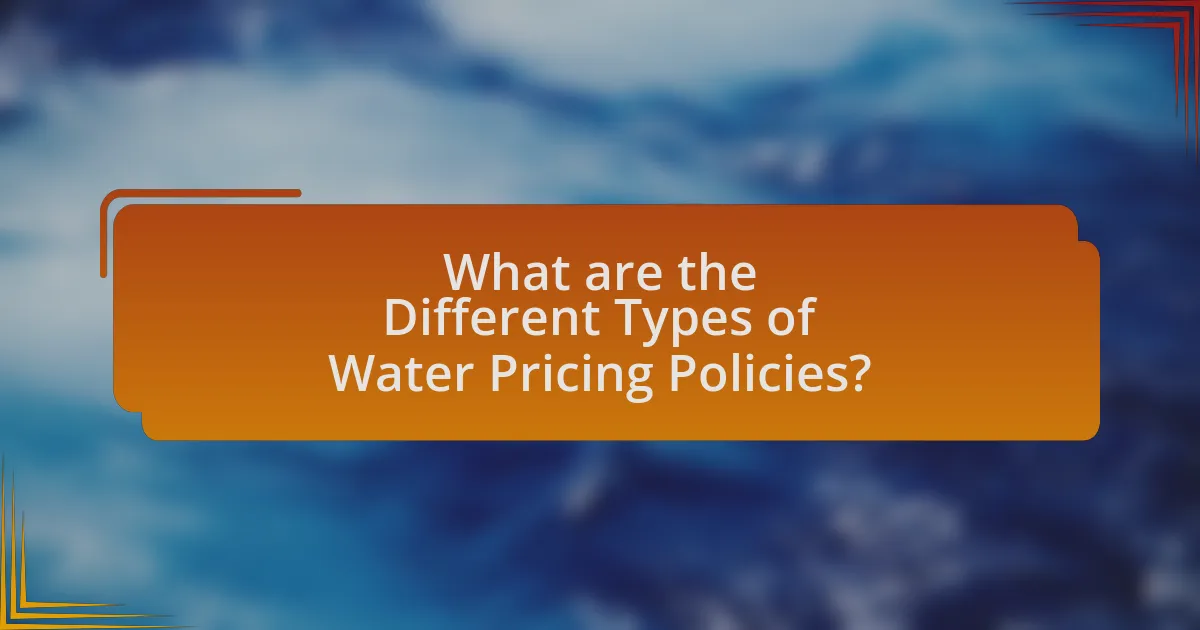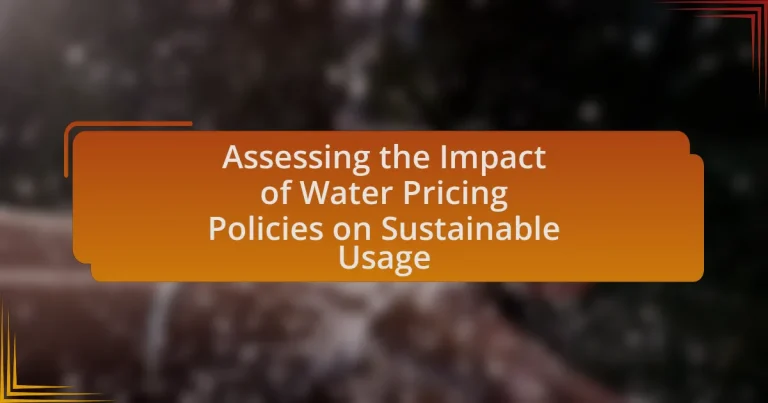Water pricing policies are regulatory frameworks designed to establish the cost of water services, promoting efficient usage and sustainability. This article examines the impact of these policies on consumer behavior, highlighting how different pricing structures, such as tiered and volumetric pricing, influence water consumption patterns. It also discusses the effectiveness of these policies in fostering sustainable water management, the environmental and economic benefits of conservation, and the challenges associated with implementation, particularly for vulnerable populations. Additionally, the article emphasizes the importance of public awareness and stakeholder engagement in enhancing the success of water pricing initiatives.
What are Water Pricing Policies and Their Purpose?

Water pricing policies are regulatory frameworks that establish the cost of water services to consumers, aiming to promote efficient water use and sustainability. These policies serve multiple purposes, including encouraging conservation, ensuring equitable access, and generating revenue for water infrastructure maintenance. For instance, tiered pricing structures charge higher rates for excessive usage, incentivizing users to conserve water. Research indicates that effective water pricing can lead to a reduction in water consumption by up to 30% in urban areas, demonstrating its role in fostering sustainable water management practices.
How do water pricing policies influence consumer behavior?
Water pricing policies significantly influence consumer behavior by altering the cost of water usage, which in turn affects consumption patterns. When prices increase, consumers are incentivized to reduce water usage through conservation measures, such as fixing leaks or using water-efficient appliances. For instance, a study by the American Water Works Association found that a 10% increase in water prices can lead to a 3-5% reduction in residential water consumption. This demonstrates that higher pricing can effectively encourage consumers to adopt more sustainable water practices, ultimately leading to reduced overall demand and promoting environmental sustainability.
What factors determine the effectiveness of water pricing policies?
The effectiveness of water pricing policies is determined by factors such as price elasticity of demand, the structure of the pricing system, public awareness, and the regulatory framework. Price elasticity of demand indicates how sensitive consumers are to changes in water prices; higher elasticity suggests that consumers will reduce usage significantly in response to price increases. The structure of the pricing system, whether it is flat-rate, tiered, or volumetric, influences consumer behavior and conservation efforts. Public awareness and education about water scarcity and pricing impacts can enhance the effectiveness of these policies by encouraging responsible usage. Lastly, a supportive regulatory framework ensures that pricing policies are enforced and aligned with sustainability goals.
How do different pricing structures impact water usage?
Different pricing structures significantly influence water usage patterns. For instance, tiered pricing, where the cost per unit increases with higher consumption, encourages conservation by incentivizing users to limit their water use to avoid higher rates. Research conducted by the American Water Works Association found that communities implementing tiered pricing saw a reduction in water consumption by approximately 10-20%. Conversely, flat-rate pricing tends to lead to higher water usage, as users do not face financial penalties for excessive consumption. This relationship between pricing structures and water usage highlights the effectiveness of economic incentives in promoting sustainable water practices.
Why is sustainable water usage important?
Sustainable water usage is important because it ensures the availability of water resources for future generations while maintaining ecological balance. Over-extraction and pollution of water sources can lead to scarcity, negatively impacting agriculture, drinking water supplies, and natural ecosystems. According to the United Nations, by 2025, two-thirds of the world’s population may face water-stressed conditions, highlighting the urgency of adopting sustainable practices. Implementing water pricing policies can incentivize conservation and efficient use, thereby promoting sustainable water management and protecting vital water resources.
What are the environmental benefits of sustainable water usage?
Sustainable water usage significantly reduces environmental degradation by conserving water resources and protecting ecosystems. By implementing practices such as rainwater harvesting and efficient irrigation, sustainable water usage minimizes water waste, which helps maintain the natural hydrological cycle. This conservation leads to healthier aquatic ecosystems, as less water extraction from rivers and lakes preserves habitats for fish and other wildlife. Additionally, sustainable practices can reduce pollution runoff into water bodies, improving water quality and promoting biodiversity. Studies indicate that regions adopting sustainable water management practices experience a decrease in water scarcity and improved resilience to climate change impacts, further supporting environmental health.
How does sustainable water usage contribute to economic stability?
Sustainable water usage contributes to economic stability by ensuring the availability of water resources for agriculture, industry, and households, which are essential for economic activities. Efficient water management practices reduce costs associated with water scarcity, such as increased prices for water supply and the need for expensive infrastructure projects. For instance, the Food and Agriculture Organization (FAO) reports that sustainable water practices can enhance agricultural productivity by up to 40%, thereby supporting food security and economic growth. Additionally, sustainable water usage mitigates the risks of droughts and floods, which can disrupt economic activities and lead to significant financial losses. By promoting resilience in water supply, economies can maintain steady growth and reduce vulnerability to climate-related shocks.
What are the Different Types of Water Pricing Policies?

The different types of water pricing policies include volumetric pricing, flat-rate pricing, seasonal pricing, and tiered pricing. Volumetric pricing charges users based on the amount of water consumed, promoting conservation by incentivizing reduced usage. Flat-rate pricing involves a fixed fee regardless of consumption, which may not encourage efficient use. Seasonal pricing adjusts rates based on demand fluctuations throughout the year, often increasing costs during peak usage periods to manage supply. Tiered pricing sets different rates for varying levels of consumption, encouraging users to stay within lower tiers to avoid higher charges. These policies aim to balance water resource management with economic considerations, supporting sustainable usage practices.
How do volumetric pricing models work?
Volumetric pricing models charge customers based on the quantity of resources consumed, typically measured in units such as gallons or cubic meters. This pricing structure incentivizes conservation by making users aware of their consumption levels; as usage increases, the cost per unit may also rise, encouraging users to reduce waste. For example, many water utilities implement tiered pricing, where the first set amount of water is charged at a lower rate, and subsequent usage is charged at higher rates, effectively promoting sustainable usage practices. Studies have shown that such models can lead to a significant reduction in water consumption, with some municipalities reporting decreases of up to 20% after implementing volumetric pricing.
What are the advantages of volumetric pricing for water conservation?
Volumetric pricing for water conservation encourages efficient water use by charging consumers based on the amount of water they consume. This pricing model creates a direct financial incentive for users to reduce their water usage, as higher consumption leads to higher costs. Studies have shown that regions implementing volumetric pricing have experienced significant reductions in water consumption; for instance, a study by the American Water Works Association found that volumetric pricing can reduce water use by 10-30%. Additionally, volumetric pricing promotes awareness of water scarcity and encourages users to adopt water-saving technologies and practices, further contributing to sustainable water management.
What challenges are associated with implementing volumetric pricing?
Implementing volumetric pricing faces several challenges, including consumer resistance, administrative complexity, and equity concerns. Consumer resistance arises as individuals may oppose changes in pricing structures, fearing increased costs or reduced access to water. Administrative complexity involves the need for accurate metering and billing systems, which can require significant investment and ongoing maintenance. Equity concerns highlight the potential for volumetric pricing to disproportionately affect low-income households, as they may spend a larger percentage of their income on water. These challenges necessitate careful consideration and planning to ensure effective implementation of volumetric pricing in water management policies.
What role do fixed charges play in water pricing?
Fixed charges in water pricing serve to ensure a stable revenue stream for water utilities, covering the fixed costs associated with infrastructure maintenance and operation. These charges are typically levied regardless of the amount of water consumed, which helps utilities manage their budgets and maintain service reliability. For instance, fixed charges can account for a significant portion of a utility’s revenue, often ranging from 30% to 70%, depending on the pricing structure. This revenue stability is crucial for long-term planning and investment in water supply systems, thereby supporting sustainable usage by ensuring that utilities can effectively manage resources and respond to demand fluctuations.
How do fixed charges affect low-income households?
Fixed charges significantly burden low-income households by imposing a financial strain regardless of their actual water usage. These households often face a higher percentage of their income allocated to fixed charges, which can lead to affordability issues and reduced access to essential services. For instance, a study by the American Water Works Association found that low-income families can spend up to 10% of their income on water bills, primarily due to fixed charges, compared to the recommended threshold of 2.5%. This disproportionate impact can result in low-income households prioritizing basic needs over water consumption, potentially leading to health risks and increased financial instability.
What are the implications of fixed charges on overall water consumption?
Fixed charges significantly influence overall water consumption by creating a baseline cost that consumers must pay regardless of usage. This pricing structure can lead to reduced incentives for conservation, as users may feel less motivated to limit their water use when a substantial portion of their bill is fixed. Research indicates that when fixed charges are high, consumers tend to use more water, as they perceive less financial benefit from reducing consumption. For instance, a study by the American Water Works Association found that households with higher fixed charges consumed approximately 10-15% more water than those with lower fixed charges, demonstrating a clear correlation between fixed pricing and increased water usage.
How Do Water Pricing Policies Affect Sustainable Usage?

Water pricing policies significantly influence sustainable usage by creating economic incentives for conservation. When water prices reflect its scarcity and environmental costs, consumers are more likely to reduce consumption and adopt water-saving practices. For instance, a study by the World Bank found that increasing water tariffs led to a 20% reduction in water usage in urban areas, demonstrating that higher prices can effectively encourage more sustainable behaviors. Additionally, tiered pricing structures, where higher usage incurs steeper charges, further promote efficient water use by discouraging wasteful practices.
What evidence exists linking water pricing to sustainable usage outcomes?
Evidence linking water pricing to sustainable usage outcomes includes studies demonstrating that higher water prices lead to reduced consumption and increased efficiency in water use. For instance, research conducted by the World Bank found that implementing tiered pricing structures can reduce water usage by up to 30% in urban areas. Additionally, a study published in the journal “Water Resources Research” indicated that regions with higher water tariffs experienced significant declines in per capita water consumption, suggesting a direct correlation between pricing and sustainable usage practices. These findings support the notion that effective water pricing policies can incentivize conservation and promote sustainable water management.
How have case studies demonstrated the impact of pricing policies?
Case studies have demonstrated that pricing policies significantly influence water consumption patterns and promote sustainable usage. For instance, a case study conducted in California showed that implementing tiered pricing structures led to a 20% reduction in water usage among residential customers during drought conditions. Similarly, research from Australia indicated that increasing water prices resulted in a 15% decrease in overall water consumption, highlighting the effectiveness of economic incentives in encouraging conservation. These examples illustrate that well-designed pricing policies can effectively alter consumer behavior and contribute to sustainable water management.
What metrics are used to assess the effectiveness of these policies?
Metrics used to assess the effectiveness of water pricing policies include water consumption reduction, cost recovery rates, and changes in user behavior. Water consumption reduction measures the decrease in water usage following the implementation of pricing policies, indicating their impact on conservation efforts. Cost recovery rates evaluate the extent to which water pricing covers the costs of supply and infrastructure, reflecting economic sustainability. Changes in user behavior are assessed through surveys and usage patterns, demonstrating shifts towards more sustainable practices. These metrics collectively provide a comprehensive evaluation of the policies’ effectiveness in promoting sustainable water usage.
What are the potential drawbacks of water pricing policies?
Water pricing policies can lead to several potential drawbacks, including inequity in access to water, reduced consumption among low-income households, and potential negative impacts on agricultural production. These policies may disproportionately affect vulnerable populations who may struggle to afford increased costs, leading to a situation where essential water access becomes a privilege rather than a right. Additionally, studies have shown that when water prices rise, low-income households often reduce their consumption to unsustainable levels, which can adversely affect their health and hygiene. Furthermore, higher water prices can discourage agricultural production, as farmers may find it economically unfeasible to irrigate crops, potentially leading to food insecurity.
How can water pricing policies disproportionately affect vulnerable populations?
Water pricing policies can disproportionately affect vulnerable populations by imposing higher costs for essential water services, which these groups may struggle to afford. For instance, when water pricing is based on consumption, low-income households often face a larger financial burden relative to their income compared to wealthier households. According to a study by the World Bank, in many regions, the poorest 20% of households spend up to 10% of their income on water, while wealthier households spend only about 1%. This disparity can lead to reduced access to clean water, increased health risks, and a greater likelihood of water-related conflicts, further exacerbating existing inequalities.
What unintended consequences might arise from poorly designed pricing policies?
Poorly designed pricing policies can lead to unintended consequences such as reduced water conservation, increased inequity among users, and potential economic strain on vulnerable populations. For instance, if pricing structures do not reflect the true cost of water or fail to incentivize conservation, consumers may overuse water resources, exacerbating scarcity issues. Additionally, flat-rate pricing can disproportionately affect low-income households, as they may pay a higher percentage of their income compared to wealthier users, leading to social inequities. Research by the World Bank indicates that ineffective pricing can result in a 20% increase in water consumption in urban areas, highlighting the critical need for well-structured pricing policies to promote sustainable usage.
What best practices can enhance the effectiveness of water pricing policies?
Best practices that can enhance the effectiveness of water pricing policies include implementing tiered pricing structures, ensuring transparency in pricing mechanisms, and integrating water pricing with conservation incentives. Tiered pricing structures encourage efficient water use by charging higher rates for excessive consumption, which has been shown to reduce water usage in various regions. Transparency in pricing mechanisms builds public trust and understanding, leading to greater compliance and support for water conservation efforts. Additionally, integrating water pricing with conservation incentives, such as rebates for water-saving technologies, can further promote sustainable usage. These practices have been validated by studies indicating that effective pricing strategies lead to significant reductions in water consumption and improved resource management.
How can stakeholder engagement improve policy outcomes?
Stakeholder engagement can improve policy outcomes by fostering collaboration and ensuring that diverse perspectives are considered in the decision-making process. Engaging stakeholders, such as community members, businesses, and environmental groups, leads to more informed policies that reflect the needs and values of those affected. For instance, research indicates that inclusive stakeholder processes can enhance the legitimacy and acceptance of policies, resulting in higher compliance rates and better implementation. A study by the World Resources Institute found that stakeholder engagement in water management led to more effective and sustainable practices, demonstrating that policies developed with stakeholder input are more likely to achieve desired environmental and social outcomes.
What role does public awareness play in the success of water pricing initiatives?
Public awareness is crucial for the success of water pricing initiatives as it directly influences consumer behavior and acceptance of pricing changes. When the public is informed about the rationale behind water pricing, including the need for sustainable usage and resource conservation, they are more likely to support and comply with these initiatives. Studies have shown that increased public awareness can lead to a reduction in water consumption; for instance, a survey conducted by the Water Research Foundation found that communities with educational programs on water pricing experienced a 15% decrease in water usage compared to those without such initiatives. This demonstrates that informed consumers are more likely to adjust their usage patterns in response to pricing signals, ultimately contributing to the effectiveness of water pricing policies in promoting sustainable water management.


